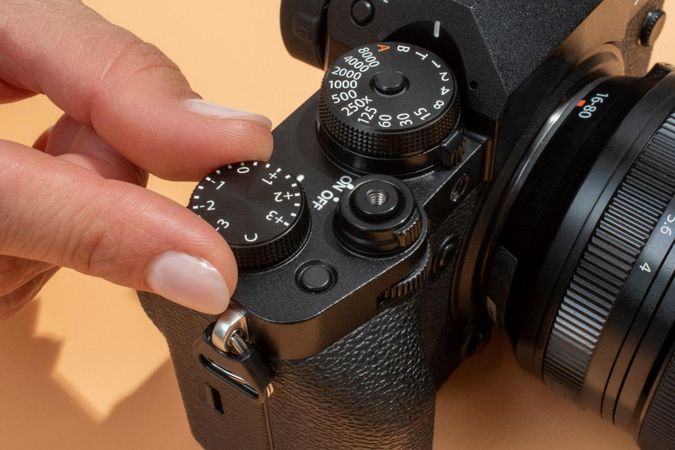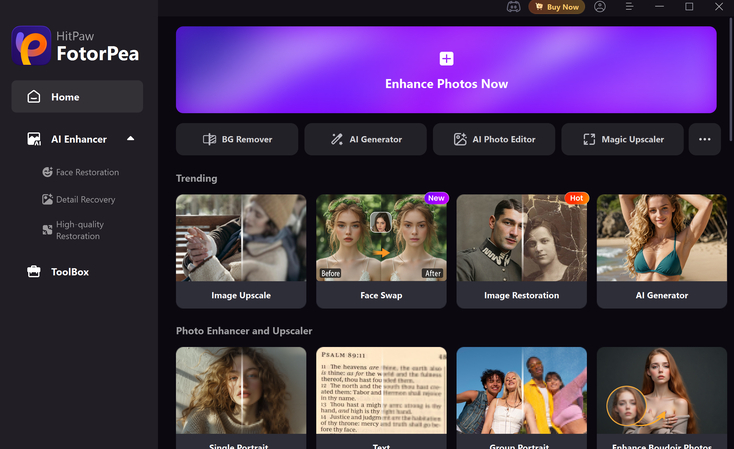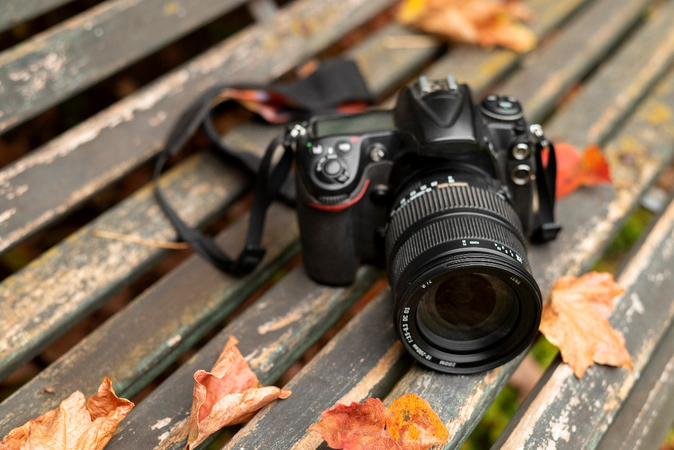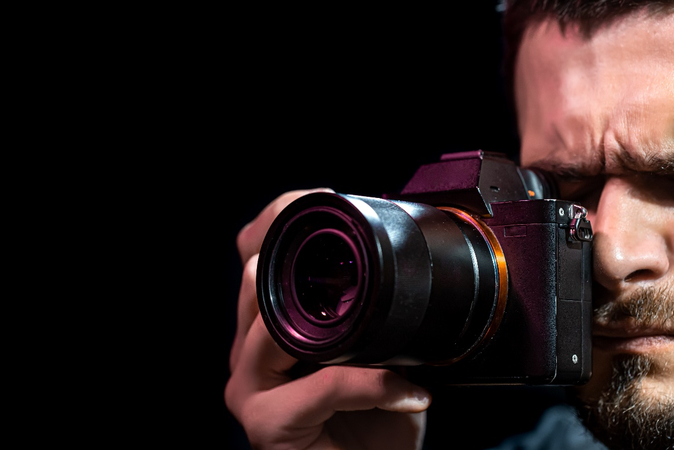Define DSLR and Understand Why It Matters in Photography
In 2025, despite the rise of smartphones and mirrorless cameras, DSLRs remain a valuable choice for photographers who prioritize optical viewfinders, long battery life, and extensive lens compatibility, especially in niches like sports and wildlife photography.Are you an aspiring amateur photographer or an expert? Both are great candidates for a DSLR camera, which provides control, quality, and classic value.
To make your DSLR images even more stunning, use HitPaw FotorPea - a powerful tool that sharpens images, removes noise, and fixes lighting in just a few clicks.
1. Define DSLR - What Does DSLR Stand For?
So, what does DSLR stand for? DSLR is short for Digital Single-Lens Reflex. A DSLR is a digital camera that combines the optics and mechanics of a single-lens reflex camera with a digital image sensor.
A DSLR possesses this important characteristic: the mirror mechanism. A mirror inside the camera body reflects the light up to an optical viewfinder when it is looked through the viewfinder. Once you push the shutter button, the mirror swings up and the light can fall directly on the image sensor.
Such design provides the photographer an optical, real-time look at the subject in contrast to mirrorless cameras, which use digital displays. And that immediate eye contact and specific framing remains one of the reasons photographers are still attracted to DSLRS today.
DSLRs offer high image quality, manual controls, long battery life, and versatile lenses, performing reliably in various lighting conditions.
2. How a DSLR Camera Works

To understand how to use a DSLR camera, it's helpful to grasp how it functions internally.
So, what goes on in a DSLR when you take a picture?
- Light enters through the lens.
- It hits a mirror angled at 45 degrees.
The mirror reflects light into a pentaprism or pentamirror, a component that corrects the image's orientation so it appears correctly in the optical viewfinder.
When the shutter is pressed, the mirror flips up, and light hits the image sensor, capturing the photo.
This procedure of the mechanical kind might now be very old-fashioned, but it is highly effective. Using it, one can achieve precise focusing, particularly in dynamic photography: sports or wildlife. Understanding this process also helps new users feel more confident when figuring out how to use a DSLR camera.
The other explanation as to why photographers adore DSLRs is its manual control. In contrast, unlike auto point-and-shoots, DSLRs will allow the user to adjust ISO, aperture and shutter speed (the essential tools towards gaining creative control over your images).
3. Enhancing DSLR Photos with HitPaw FotorPea
Even the finest photos may need slight enhancements, and that's where software steps in.
A reliable DSLR photo editing software helps adjust lighting, correct colors, and sharpen details. And for both beginners and experts, HitPaw FotorPea stands out as a go-to solution.
| Feature | Description |
|---|---|
| AI-Powered Enhancement | Upscales to 4K/8K, restores blurry/old photos with one-click AI technology. |
| Specialized AI Models | Face, Denoise, Colorize, Scratch Repair models for specific editing needs. |
| User-Friendly Interface | Simple, no skills needed, supports batch processing for multiple images. |
| Versatile Editing | Background/object removal, face swapping, ID photo creation. |
| Old Photo Restoration | Revives faded/damaged photos with natural colorization and clarity. |
| Cross-Platform Support | Available on Windows, macOS, online, and mobile apps. |

4. DSLR vs. Mirrorless Cameras - Key Differences
One of the most common questions beginners ask is the difference between DSLR and mirrorless cameras.
The following are the significant differences:
| Feature | DSLR | Mirrorless |
|---|---|---|
| Viewfinder | Optical (real view) | Electronic (digital screen) |
| Size & Weight | Bulkier | Compact and lighter |
| Battery Life | Longer | Shorter |
| Autofocus | Reliable phase-detection | Fast, accurate, with subject tracking |
| Lens Options | Broad and mature | Extensive, growing |
While mirrorless cameras are popular for their compact designs and advanced features, DSLRs remain reliable for photographers who prioritize optical viewfinders, long battery life, and a robust lens ecosystem.DSLRs still present a significant competency in the modern world of photography due to the optical viewfinder, long battery life, and the feel of shooting.
5. Types of DSLR Cameras and Who They're For
Not every DSLR is one of the same kind. The various models address different levels of expertise as well as requirements. Understanding the types of DSLR cameras helps you make a smarter purchase based on your goals.
Entry-Level DSLRs for Beginners

If you're just getting started, an entry-level DSLR camera for beginners is your best bet. These are generally lightweight, easy and cheap. They have built-in manuals and auto settings and are suitable to learn the ropes.
An example is the many cameras that have more straightforward design controls, scene mode, and of course, the help menu, which explains as you shoot.
Mid-Range to Professional DSLRs

Professional and mid-range DSLRs are models working with more serious photographers. They include weather seal, dual card slots, high resolution sensors, and high processing speeds. These are the cameras that deal with sophisticated lighting, high speed and artistic manipulation efficiently.
These are generally used by photographers working in weddings, wildlife or commerce due to their longevity and functionality.
6. Choosing Based on Photography Niche
Consider the type of photography you would like to perform. DSLRs with large sensors and fast prime lenses will be helpful to portrait shooters. Wide dynamic range weather-resistant DSLRs can be more desirable to landscape lovers. The types of DSLR cameras available today cover virtually every creative need.
7. DSLR Photography Tips for Beginners
You are just beginning to get into the field of photography? Here are practical DSLR photography tips for beginners:
- Learn the exposure triangle - ISO, aperture, and shutter speed. This forms the foundation of good photography.
- Use the rule of thirds for better composition.
- Shoot in RAW format to capture more data for editing.
- Keep your ISO low in bright light for cleaner images.
- Experiment with angles and lighting for creative results.
- Use a tripod for stability during low-light or long exposure shots.
The other thing is to experiment with your camera features. Manual Mode (M) allows complete control, whereas Aperture Priority (A or Av) is beneficial with portraits, and Shutter Priority (S or Tv) is helpful on action shots. Knowing how to use a DSLR camera beyond Auto Mode makes all the difference.
8. Best DSLR Camera Settings for Portraits and Landscapes
Using the best DSLR camera settings for portraits and landscapes helps elevate your image quality significantly.
Portrait Settings:
- Aperture: f/1.8 to f/4 for a blurred background
- Shutter Speed: 1/125 or faster
- ISO: 100-400 in good lighting
- Lens Suggestion: 50mm or 85mm prime
Landscape Settings:
- Aperture: f/8 to f/16 for deep focus
- Shutter Speed: Depends on lighting, may need tripod
- ISO: Always lowest possible (e.g., ISO 100)
- Use manual focus for edge-to-edge clarity
These best DSLR camera settings for portraits and landscapes help ensure you're capturing clean, sharp, and vivid images every time.
9. DSLR FAQs
DSLR is a short name for Digital Single-Lens Reflex. It is defined as a camera that involves the use of a mirror & prism system, allowing the camera user to view directly through the lens using an optical viewfinder.
Yes, a DSLR camera for beginners is a fantastic choice. It provides hands-on controls, a quality image, and space to develop as you get acquainted with the basics of photography.
Absolutely. Although mirrorless cameras are trending, DSLR continues to be in the market and are still supported. Their functionality, practicality of use and lens compatibilities make them perform, stay relevant and efficient in 2025.
Editing will enhance contrast, correct exposure and pick out the good aspects of your photograph. Using DSLR photo editing software like HitPaw FotorPea makes your images look polished and professional - even if you're starting.
Final Thoughts
In 2025, DSLRs remain reliable and satisfying, with optical viewfinders, long battery life, and ergonomic designs that appeal to many photographers.
Whether you're using an entry-level DSLR camera for beginners or a high-end model, your results can truly shine with thoughtful editing. Enhance those captures easily with HitPaw FotorPea - the easiest way to make your DSLR photos look stunning.
Leave a Comment
Create your review for HitPaw articles









